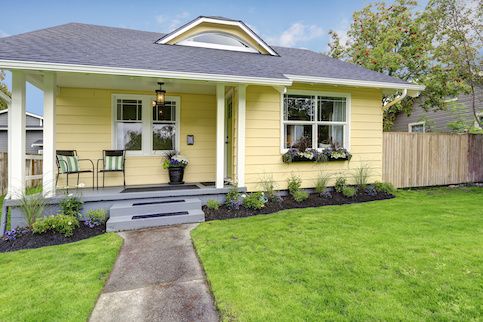How Does Mortgage Interest Work? A Complete Guide

When you make your mortgage payment each month, only a portion of those dollars goes toward paying off your loan’s principal balance, the amount that you still owe on your loan. A good chunk of your payment, especially in the earliest days of your mortgage, goes toward paying off the interest on your loan instead.
Interest is the money your lender charges to originate and service your loan. Depending on the mortgage you take out and how long you keep it, you’ll pay more or less interest over its life.
As a home buyer, you need to understand how mortgage interest works. It’s a key way to understand how much you’ll pay for your loan.
Why You Pay Mortgage Interest On Your Home Loan
When you apply for a mortgage loan, your lender will check your three-digit credit score. It will also consider your monthly debts and the term of your loan. Armed with this information, your lender will then attach an interest rate to your loan.
If you want the lowest rate, you’ll typically need a high credit score, low levels of debt and a shorter-term loan. In general, you’ll pay a higher rate the longer your loan’s term. For instance, you’ll have a higher rate with a 30-year fixed-rate loan than you would with a 15-year fixed-rate one.
The higher your interest rate, the higher your monthly payment will be. Lenders typically charge borrowers more interest if they consider them to be a higher risk to lend to. For example, a lower credit score may show you’ve had trouble handling debt in the past. A longer term means there’s more time to get repaid and more time to potentially miss a payment. Because of this, lenders may charge you a higher interest rate as a type of financial safety net.
See What You Qualify For
Home Purchase
Home Refinance
Tap Into Equity
How Mortgage Interest Is Calculated
There is a formula that determines how much interest you’ll pay on your mortgage loan each month.
Usually, your lender will take your loan balance at the end of the month and multiply it by your loan’s interest rate. Your lender will then divide that amount by 12. The resulting figure is the amount of interest you’ll pay that month.
Say you owe $300,000 on your mortgage and your interest rate is 6.5%. First, your lender will multiply $300,000 by 0.065 to come up with $19,500. Dividing that $19,500 by 12, your lender will end up with $1,625, the amount you’d pay for interest that month.
As you pay down your mortgage’s principal balance, you’ll pay less interest each month. That’s because your lender will be multiplying a smaller figure by your loan’s interest rate.
This is partly why you pay less in interest with a shorter-term loan. Because you’re paying back your loan in a shorter number of years, you make a larger monthly payment. That in turn reduces your principal balance faster, which then reduces the amount of interest you’ll pay.
You’ll also pay less in interest if you have a lower interest rate. That’s because your lender will multiply your loan’s principal balance by a smaller figure each month.
Consider that $300,000 mortgage balance above. If your interest rate is 5.5% instead of 6.5%, your lender would multiply your $300,000 balance by 0.055, which comes to $16,500. Divide that by 12 and you get $1,375. That’s $250 less than you would have paid with an interest rate of 6.5%.
This is why getting the lowest interest rate is so important. It’s also why building a high credit score matters: Your higher credit score can boost the odds of a qualifying for a lower interest rate.
How Mortgage Interest Works By Loan Type
The key to how much interest you’ll pay with each mortgage payment depends on your mortgage amortization schedule.
Amortization is basically your loan’s repayment schedule. It lists how many payments you’ll make over the life of your loan and how much you’ll pay each month. It also lists how much of your payment goes toward paying down your loan’s principal balance and how much goes toward interest.
As your loan amortizes over time, you’ll steadily pay more on its principal balance. During this time, you’ll build more equity in your home. Equity is the difference between what you owe on your mortgage and what your home is worth and is important. That’s because you can borrow against it in the form of home equity loans or home equity lines of credit (HELOCs), using the funds from these loans however you’d like.
Fixed-Rate Vs. Adjustable-Rate Mortgages (ARMs)
Two of the more popular types of loans are fixed-rate and adjustable-rate mortgages (ARMs).
- In a fixed-rate loan, your interest rate remains the same throughout the life of your mortgage.
- With an adjustable-rate mortgage, your interest rate remains fixed for a set number of years, usually 5 or 7. After this fixed period ends, your rate will adjust, often rising or falling once a year depending on whatever economic index it is tied to.
Fixed-rate loans are a good choice if you want more certainty in your principal and interest portion of your mortgage payments. Your monthly payment can still change depending on how much you’ll need to pay each year for property taxes and homeowners’ insurance.
The benefit of an adjustable-rate loan is that its initial interest rate is often lower than what you’d get with a fixed-rate loan. That can save you money in the early years of this loan type. The risk comes during the adjustable phase: Your interest rate might increase enough to boost your mortgage payment to a level that you can’t afford if you haven’t accounted for this in your budget.
Fixed-Rate Mortgages
There are several types of fixed-rate mortgages, but the most common ones are 15-year and 30-year fixed-rate loans. The longer your term with a fixed-rate loan, the lower your monthly payment will be but the more you’ll pay in interest throughout its life.
Say you take out a 30-year fixed-rate loan of $375,000 with an interest rate of 6.56%. You’ll pay $2,385 a month, not counting what you might pay in property taxes and interest. You’d pay a total of $483,680 in total interest if you take the full 30 years to pay off this loan.
If you borrowed the same amount as a 15-year fixed-rate loan with an interest rate of 5.76%, you’d pay $3,116 a month, again not including taxes and insurance. But you’ll only pay $185,893 in total interest over the life of this loan, making it a less costly loan than the 30-year version.
With fixed-rate mortgages, more of your payment each month will go toward paying down your loan’s principal balance over time.
Adjustable-Rate Mortgages
The amount of interest you pay on an adjustable-rate mortgage changes over time. During your fixed period, your interest rate will not change and your monthly payments will remain consistent. But once your loan enters its adjustable phase, your rate, and your monthly payment, can rise or fall depending on the performance of whatever economic index your loan is tied to.
This means that you’ll pay more interest the longer you hold onto your adjustable-rate mortgage. It’s why many borrowers refinance out of an adjustable-rate loan to a fixed-rate version before their loan enters its adjustable period.
Say you take out a 30-year adjustable-rate mortgage of $350,000 at an interest rate of 5%. Say, too, that your mortgage is a 5/1 ARM. This means that your interest rate remains fixed at 5% for five years and then adjusts once every year for the remaining 25 years of your mortgage.
Assume that your interest rate will rise 0.25% every year once your ARM enters its adjustable period. Your first monthly payment, not including taxes or insurance, would be $1,878.88. If you carry the loan for the full 30 years, your highest monthly payment, because of increasing interest, would be $2,620.96.
This jump in monthly payment is why so many homeowners choose to refinance out of an ARM before their loan’s interest rate begins adjusting.
Jumbo Loans
As the name suggests, jumbo loans are bigger than your typical mortgage.
A jumbo loan is any mortgage lending more than the conforming loan limit set by the Federal Housing Finance Agency (FHFA). In most parts of the country in 2023, any mortgage of more than $726,200 for a one-unit property is considered a jumbo loan. In high-cost areas of the country, such as New York City and Los Angeles, loans of more than $1.089 million for one-unit properties are considered jumbo loans.
Because these loans are riskier, lenders will typically charge higher interest rates for them. And because the principal balances are so high, you’ll spend more on interest during the life of these loans.
Consider a 30-year fixed-rate loan of $800,000 at an interest rate of 7%. You’d pay $5,322 a month, not including property taxes and insurance, and a total of more than $1.116 million in interest if you hold onto this loan for the full 30 years.
Shop Around For Lower Interest Rates
The interest rate attached to your mortgage loan is a major factor in determining how much interest you’ll pay on your loan. That’s why it makes sense to shop for the lender who offers the lowest rate.
But be careful. The loan with the lowest interest rate isn’t always the most affordable. That’s because lenders and other third-party providers charge closing fees when you take out a mortgage. Depending on how high a loan’s closing fees are, it might be more expensive than a similar loan with a slightly higher interest rate.
That’s why it’s best to compare the annual percentage rate (APR) of different loans when shopping for the most affordable mortgage. The APR is a measure of how much a loan costs when factoring in both its interest rate and closing fees. APR, then, shows you how expensive a loan is in total. When comparing loans from different lenders, look at the APR – which is always higher than a loan’s interest rate – to make the most accurate comparison.
The Bottom Line
If you’re hunting for a new home or considering refinancing your existing loan, to begin the mortgage approval process. And be sure to consider both a loan’s interest rate and APR when calculating which mortgage fits in your household budget.











